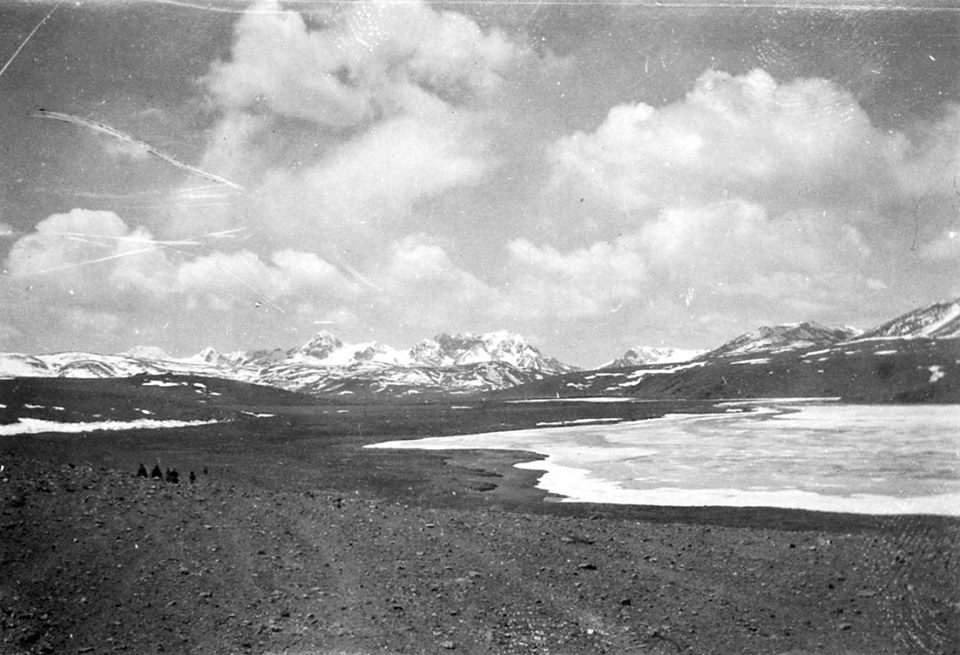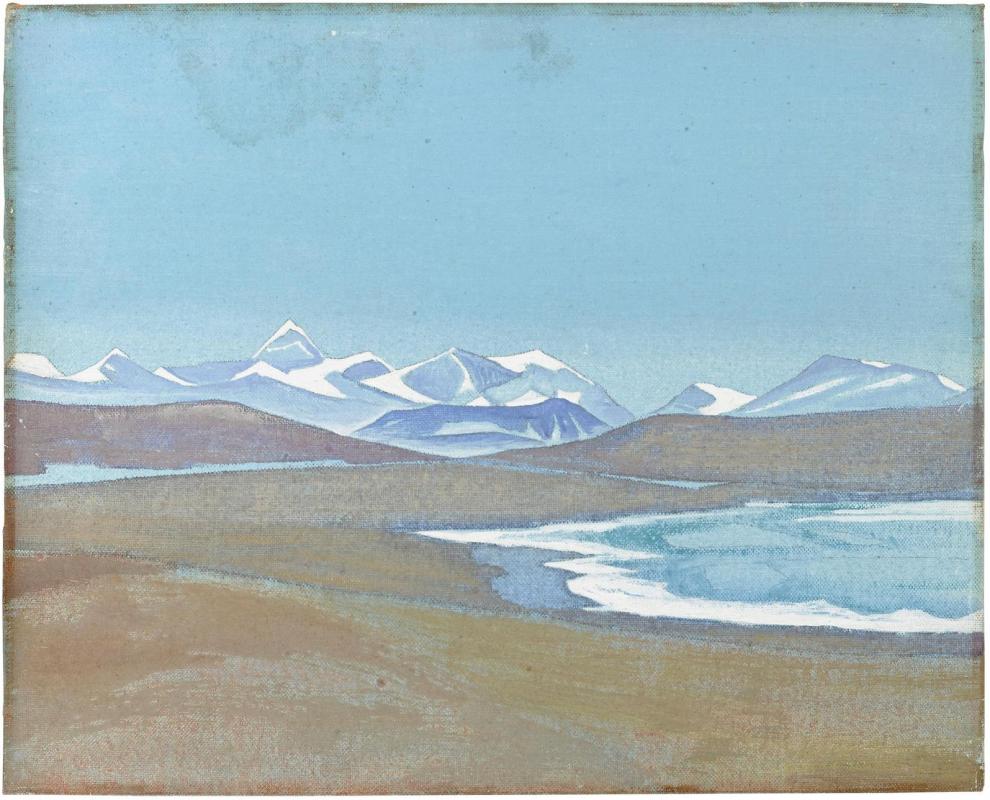 >>
>>
| Картины Н.К.Рериха |
<<  >> >>
| сменить фон |
Ссылка на изображение: http://gallery.facets.ru/pic.php?id=3976&size=5
| |
|
|
|
|
|
| Обороты: | |
|
|
|
||||||||||||||
|
||||||||||||||
|
||||||||||||||
 |
||||||||||||||
|
||||||||||||||
Ист.:https://www.bonhams.com/auction/24666/lot/34/nikolai-konstantinovich-roerich-1874-1947-costume-design-for-le-sacre-du-printemps-circa-1910-1913-31-x-35cm-12-316-x-13-34in/
Настоящий лот был выполнен в Дарджилинге, Индия, куда Николай Рерих и его экспедиционная группа прибыли в конце мая после пересечения Монголии и Тибета с севера на юг. Он оставался в Дарджилинге до декабря, запечатлев свои впечатления от путешествия в нескольких десятках работ.
Экспедиция прошла через Тинг-кье, тибетский район недалеко от границы с Сиккимом, 13 мая 1928 года и отдыхала там целый день. Они разбили лагерь на восточном берегу озера, откуда открывается вид на белые гималайские вершины, которые мы видим на заднем плане. Сын художника, Георгий Рерих, отмечает, что они останавливались "в бывшем кемпинге экспедиции на Эверест", а также что в этом районе "была исключительно снежная зима...и многие люди погибли на перевалах через Гималаи... Высокие перевалы к югу от Тинг-кье все еще были непроходимы". (Тропы внутренней Азию, 484)
Картина характерна для способности Рериха превратить горный пейзаж в символ величия и красоты жизни, предлагая заглянуть в то, что он любил называть "сверхземным". Он использовал всего около дюжины строк, чтобы вернуть нас к тому времени, когда Гималаи все еще были идеей в сознании создателя, абстракциями возвышающихся вершин до того, как они затвердели в камень и лед. Именно эту точку зрения можно узнать на фотографии, сделанной участником экспедиции, и это помогает нам понять, почему Рерих стал известен как "повелитель гор". Плоские плоскости земли наклоняются вниз, уплотняя пространство между зрителем и горным хребтом, делая его одновременно удаленным и сразу доступным. В то же время два взаимосвязанных контура, сходящихся у подножия гор, поддерживают композицию в идеальном равновесии. Рерих выделяет и подчеркивает эту центральную точку из природного ландшафта, отмечая четкий путь для своего путешествия в горы. |
||||||||||||||
|
||||||||||||||
2010 http://www.bonhams.com/auctions/17862/lot/71/ Lot 71* £ 80,000 - 100,000 RUB 6,600,000 - 8,300,000 THE RUSSIAN SALE 1 Dec 2010, 10:00 GMT LONDON, NEW BOND STREET Nikolai Konstantinovich Roerich (Russian, 1874-1947) Himalayas, from Ting-kye Dzong, 1928 numbered (on verso) 'N 18' and dated '1928' by the artist; verso further applied with Roerich Museum label inscribed 17 Himalayas by Nicholas Roerich/849 tempera on canvas laid on board 33 x 41cm (13 x 16 1/8in). FOOTNOTES PROVENANCE Roerich Museum, New York, 1928-1935 Nettie & Louis Horch collection, New York Acquired from the above by the present owner in mid 1970s
EXHIBITED Roerich Museum, New York (permanent collection), 1928-1935, no. 849
LITERATURE Roerich Museum Catalogue, New York: Roerich Museum, 1930. p.33
The present lot was executed in Darjeeling, India, where Nicholas Roerich and his expedition party arrived at the end of May after crossing Mongolia and Tibet from north to south. He stayed in Darjeeling until December, recording his impressions from the journey in several dozen works.
The expedition passed through Ting-kye, a Tibetan area close to the Sikkim border, on May 13th, 1928 and rested there for an entire day. They camped on the eastern shore of a lake that opens up to the white Himalayan peaks that we see in the background. The artist's son, George Roerich, remarks that they stayed 'at the former camping place of the Mount Everest Expedition' and also that the area 'had had an exceptionally snowy winter...and many people had perished on the passes across the Himalayas...the high passes south of Ting-kye were still impassable.' (Trails to Inmost Asia, 484)
The painting is characteristic of Roerich's ability to turn a mountain landscape into a symbol of life's grandeur and beauty offering a glimpse into what he loved to call the 'super mundane'. He used only a dozen or so lines to take us back to the time when the Himalayas were still an idea in the mind of the creator, abstractions of towering peaks before they solidified into stone and ice. One can recognise this particular viewpoint in the photo taken by a member of the expedition, and it helps us understand why Roerich became known as a 'master of mountains'. Flat planes of earth slope downward to condense the space between the viewer and mountain range, making it both remote and immediately accessible. At the same time, the two interlocking outlines that converge at the base of the mountains keep the composition in perfect balance. Roerich extracts and emphasises this centre point from the natural landscape, marking a clear path for his journey into the mountains.
We are grateful to Gvido Trepša, Senior Researcher, Nicholas Roerich Museum, New York for his assistance in preparing this catalogue entry.
2016 http://www.bonhams.com/auctions/23438/lot/50/ Lot 50* NIKOLAI KONSTANTINOVICH ROERICH (1874-1947) Himalayas from Ting-kye Dzong, 1928 33 x 41cm (13 x 16 1/8in). £60,000 - 80,000 RUB 4,800,000 - 6,400,000 THE RUSSIAN SALE 15:00 GMT LONDON, NEW BOND STREET Nikolai Konstantinovich Roerich (1874-1947) Himalayas from Ting-kye Dzong, 1928 numbered (on verso) 'N 18' and dated '1928' by the artist; verso further applied with Roerich Museum label inscribed 17 Himalayas by Nicholas Roerich/849 tempera on canvas laid on board 33 x 41cm (13 x 16 1/8in). FOOTNOTES Provenance Roerich Museum, New York, 1928-1935 Nettie & Louis Horch collection, New York Acquired from the above by the present owner in mid 1970s
Exhibited Roerich Museum, New York (permanent collection), 1928-1935, no. 849
Literature Roerich Museum Catalogue, New York: Roerich Museum, 1930. p.33
The present lot was executed in Darjeeling, India, where Nicholai Roerich and his expedition party arrived at the end of May after crossing Mongolia and Tibet from north to south. He stayed in Darjeeling until December, recording his impressions from the journey in several dozen works.
The expedition passed through Ting-kye, a Tibetan area close to the Sikkim border, on May 13th, 1928 and rested there for an entire day. They camped on the eastern shore of a lake that opens up to the white Himalayan peaks that we see in the background. The artist's son, George Roerich, remarks that they stayed 'at the former camping place of the Mount Everest Expedition' and also that the area 'had had an exceptionally snowy winter...and many people had perished on the passes across the Himalayas...the high passes south of Ting-kye were still impassable.' (Trails to Inmost Asia, 484)
The painting is characteristic of Roerich's ability to turn a mountain landscape into a symbol of life's grandeur and beauty offering a glimpse into what he loved to call the 'super mundane'. He used only a dozen or so lines to take us back to the time when the Himalayas were still an idea in the mind of the creator, abstractions of towering peaks before they solidified into stone and ice. One can recognize this particular viewpoint in the photo taken by a member of the expedition, and it helps us understand why Roerich became known as a 'master of mountains'. Flat planes of earth slope downward to condense the space between the viewer and mountain range, making it both remote and immediately accessible. At the same time, the two interlocking outlines that converge at the base of the mountains keep the composition in perfect balance. Roerich extracts and emphasizes this centre point from the natural landscape, marking a clear path for his journey into the mountains.
We are grateful to Gvido Trepša, Executive Director, Nicholas Roerich Museum, New York for his assistance in preparing this catalogue entry. |
||||||||||||||

